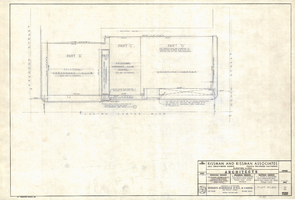Search the Special Collections and Archives Portal
Search Results

Binion's Horseshoe Plot Plan: architectural drawing
Date
Archival Collection
Description
From the Homer Rissman Architectural Records (MS-00452). Written on the image: "Rissman and Rissman Associates 1011 Swarthmore Avenue Pacific Palisades California Gladstone 4-7519. Scale 1"=20'-0". Architects. Structural Engineer Socoloske, Zelner & Assoc. 14545 Friar Street Van Nuys, Calif. 91401 State 5-6821. Mechanical Engineer W.L. Donley & Associates 1516 North West Avenue Fresno, Calif. 93728 268-8029. Electrical Engineer J. L. Cusick & Associates 4219 Lankershim Blvd. North Hollywood, Cal. 91602 Triangle 7-6231. 7-15-68 Date. Additions & Alterations. Binion's Horseshoe Hotel & Casino 200 Fremont Street Las Vegas Nevada, 89101. Phone: 702/382-1600. Plot Plan. 2 Drawing Number".
Image

Binion's Horseshoe First Floor As-Built and Demolition Plan: architectural drawing
Date
Archival Collection
Description
From the Homer Rissman Architectural Records (MS-00452). Written on the image: "Rissman and Rissman Associates 1011 Swarthmore Avenue Pacific Palisades California Gladstone 4-7519. Scale 1/8"=1'0". Architects. Structural Engineer Socoloske, Zelner & Assoc. 14545 Friar Street Van Nuys, Calif. 91401 State 5-6821. Mechanical Engineer W.L. Donley & Associates 1516 North West Avenue Fresno, Calif. 93728 268-8029. Electrical Engineer J. L. Cusick & Associates 4219 Lankershim Blvd. North Hollywood, Cal. 91602 Triangle 7-6231. Additions & Alterations. Binion's Horseshoe Hotel & Casino 200 Fremont Street Las Vegas Nevada, 89101. Phone: 702/382-1600. First Floor As-Built & Demolition Plan. 7-15-68 Date. 4 Drawing Number. 8-27-68 Revised".
Image
Arlene Mathews Smith Photograph Collection
Identifier
Abstract
The Arlene Mathews Smith Photograph Collection (1910-1945) is comprised of photographs of people and places in and around Panaca, Nevada. The collection contains a photograph album featuring Smith, her family and friends, and various residents and events around the area. Included as part of the collection are photographs from the Last Frontier Hotel in Las Vegas, Nevada.
Archival Collection
T. David Horton Photographs of Pioche, Nevada
Identifier
Abstract
The T. David Horton Photographs of Pioche, Nevada contain black-and-white photographs of several buildings in Pioche, Nevada in the 1960s. The collection contains photographs of the Pioche Power and Light Company, Pioche’s mine, crushing plant, cemetery, and oversize photographs of the town.
Archival Collection
John R. Bruckman Photographs of Nellis Air Force Base
Identifier
Abstract
The John R. Bruckman Photographs of Nellis Air Force Base contain photographs of Nellis Air Force Base near Las Vegas, Nevada from 1951 to 1954. The collection includes photographs of the Nellis Air Force Base Baseball Team, base headquarters, buildings on the base, and soldiers outside of the Last Frontier Hotel in Las Vegas.
Archival Collection
University of Nevada, Las Vegas School of Medicine Press Clippings and Publicity Collection
Identifier
Abstract
The University of Nevada, Las Vegas School of Medicine Press Clippings and Publicity Collection is comprised primarily of newspaper clippings and magazine articles from 2013 to 2015 covering the development of a medical school at UNLV. The collection materials include op-eds on UNLV's School of Medicine and articles discussing funding, development, and administration for the school. This collection also includes a copy of the
Archival Collection
Marisa Rodriguez oral history interview
Identifier
Abstract
Oral history interview with Marisa Rodriguez conducted by Maribel Estrada Calderón, Monserrath Hernández and Claytee D. White for the Latinx Voices of Southern Nevada Oral History Project.
Marisa Rodriguez discusses her childhood and living in North Las Vegas as a teenager; she was born in Chicago, Illinois, moved to Mexico with her family at a young age, and returned to the United States at age 12. She recounts what it was like acclimating to American life, learning English, and studying abroad in Spain before becoming a law student. Marisa attended the William S. Boyd School of Law and is currently a civil litigator in Las Vegas.
Subjects discussed include: La Voz Hispanic/Latino Law Students Association at the William S. Boyd School of Law; Huellas mentorship program.
Archival Collection
Las Vegas PRIDE Parade Records
Identifier
Abstract
The Las Vegas PRIDE Parade Records (2016-2017) contain administrative files that document how the Southern Nevada Association of PRIDE, Inc. (SNAPI) organized the 2016 and 2017 PRIDE parades in Las Vegas, Nevada. Materials include correspondence with event organizers, parade participant information, and PRIDE event guides.
Archival Collection
Kathy Augustine Papers
Identifier
Abstract
The Kathy Augustine Papers date from 1977 to 1997 and are comprised of the documents of Augustine's political career as an Assemblywoman and State Senator in Nevada. The collection includes political correspondence relating to State Senate Bills (SB) and Assembly Bills (AB), material from Augustine's Assembly campaign, and newsletters from Desert Express, Sage, and Sagehen. The collection also includes other correspondence related to Augustine's time in office, and social events.
Archival Collection
UNLV Libraries Collection of Las Vegas Sands Corporation Reports and Press Materials
Identifier
Abstract
UNLV Libraries Collection of Las Vegas Sands Corporation Reports and Press Materials includes financial reports, press releases, and press kits for Las Vegas Sands Corporation dating from 1995-2008.
Archival Collection
